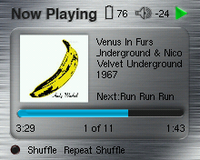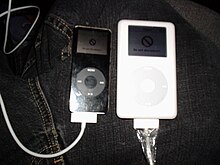Rockbox
 | |
 Main menu using default theme | |
| Developer | The Rockbox Project |
|---|---|
| Written in | C, assembly language |
| Source model | Open source |
| Initial release | June 2, 2002 |
| Latest release | 3.15 / November 15, 2019[1] |
| Latest preview | Daily |
| Repository | |
| Marketing target | digital audio players |
| Platforms | Digital audio players, various |
| Default user interface | GUI |
| License | GNU GPLv2 or later |
| Official website | www |
Rockbox is a
Rockbox runs on a wide variety of devices with very different hardware abilities: from early Archos players with 1-bit character cell-based displays, to modern players with high resolution color displays, digital optical audio hardware and advanced recording abilities.
History
The Rockbox project began in late 2001 and was first implemented on the early Archos series of hard-disk based MP3 players/recorders (including the flash-only model Ondio), because of owner frustration with severe limitations in the manufacturer-supplied user interface and device operations. These devices have relatively weak main central processing units (CPU), and instead offload music playback to dedicated hardware MP3 decoding chips (MAS).[6] Rockbox was unable to significantly alter playback abilities. Instead, it offered a greatly improved user interface and added plug-in functions absent in the factory firmware. Rockbox can be permanently flashed into flash memory on the Archos devices, making it a firmware replacement.
Versions of Rockbox have since been produced for more sophisticated devices. These perform audio decoding in
The first of these ports, beginning in late 2004, was for the
As of 2012[update] all Rockbox ports have been accomplished by reverse engineering with little or no manufacturer assistance. As free software, many Rockbox developers and supporters hope to eventually see official manufacturer support for new ports, or at least unofficial assistance in porting Rockbox to new devices. Only a few companies have expressed interest in Rockbox, and none have officially contributed code to the project or included it with their hardware. The Sansa e200v1 port is the first to be started at the request of the hardware manufacturer, who gave the Rockbox team samples of their devices.
Rockbox is continuously developed, with new
As of 2021, there have been no new ports released.
Future
Rockbox is targeted primarily at
In a chat after my Rockbox talk at Fosdem 2010, two other core Rockbox developers (Zagor and gevaerts) seemed to agree to the general view that a Rockbox future involves it running as an application. Out of the existing systems mentioned above, I'd prefer to start this work focused on Android. It has the widest company backing combined with open source, and it's also the most used open phone OS. I don't think there's anything that will prevent us from working on all those platforms, as the back-bone should be able to remain the same and portable code we already have and use. Heck, it could then also become more of a regular app for common desktops, too.[11]
A project to port Rockbox to run as an application under a full-fledged operating system was accepted for
Customization

Subject to the limitations of each particular platform, the appearance of Rockbox can be customised in various ways. Fonts and foreground and background colours can be added and selected, while a simple markup language can be used to create themes for the menu and playback screens.[16] These themes can include backgrounds and other images (such as icons), plus various formats for file names, ID3 tags, album art, file progress, and time and system information.
Rockbox has essentially been a file-tree based player, to which folders could be dragged and dropped and then navigated by folder structure. However, more recent versions have included a complementary database feature which allows the player to compile information from the files' ID3 tags.[17] The user can then navigate the files regardless of file structure.
Features
Target status
Rockbox has many features additional to those supported by the original operating firmware, but in many cases there are limitations. On platforms classified as "stable" and supported, the device can be used as a digital music player, but even on some such platforms Rockbox does not support charging or USB; the player must be dual-booted into the original firmware to be charged or to transfer files. Some platforms are classified as "unstable", but supported; those deemed "unusable" are not supported, and their use is not recommended. Some porting projects are in a pre-development hunting and gathering stage, with no code written.[18]
Codecs
Rockbox on software decoding platforms (non-Archos) supports playback of twelve
Lossy formats
- MPEG audio layers I-III (MP3/MP2/MP1)
- Ogg Vorbis
- MP4 or RMcontainers)
- Musepack
- AC3 (raw or RM container)
- WMA Standard
- WMA Professional
- Speex
- Cook
- ATRAC3
- The lossy portion of WavPack hybrid files
- Opus
Lossless formats
- FLAC
- ALAC
- WavPack
- Shorten
- Monkey's Audio
- TTA
Uncompressed formats
Together they include over a dozen different
Miscellaneous formats
In addition, there are playback of game audio types
Some profiles in Monkey's Audio are not real time on all targets due to very high CPU needs. Also, Rockbox will not play files with a digital rights management (DRM) scheme.
Rockbox features
Beside the ability of playing and recording audio files, Rockbox offers many playback enhancements that other firmware packages may not have implemented yet. Listed below are a handful of these features.
- Gapless playback[22]
- Crossfading[23]
- ReplayGain[24]
- 10 band fully parametric equalizer[24]
- Variable speed decoding with pitch correction[25]
- Crossfeed[24]
- OTF ("on the fly") playlists
- True random shuffle (fresh randomly shuffled list every time)
- Custom UI themes[26]
- Dynamic Playlists (queue files to play next, or in other parts of a dynamic playlist)
- Stereo voice/MIC & FM radio recording to WAV/AIFF/WavPack (lossless) and MP3[27][28] (limited model/device/target support)
- Remote control (supporting devices)
- Digital S/PDIF input/output (supporting devices)
- Last.fm support (even on players lacking RTC)
- Cue sheet support
- Album art[29]
- Sleep timer
Plug-ins
Rockbox developers can create plug-ins, which provide the user with other enhancements that may not be available on various firmware modules.
Available plug-ins include:
- JPEG viewer (16 bit color/129 shade greyscale)[30]
- Rockboy Game Boy emulator (port of Gnuboy)[31]
- ZXBox ZX Spectrum emulator (port of Spectemu)[32]
- PrBoomengine)
- Duke Nukem 3D, Quake, and Wolfenstein 3D running atop a version of the Simple DirectMedia Layer runtime
- XWorld, a clone of Another World[33]
- WAV to MP3 and Wavpack encoder
- MPEG video player[34]
- PictureFlow, an album art viewer similar to Apple's Cover Flow
- Various games including Solitaire, Chess, Minesweeper, Pong and many others (see https://www.rockbox.org/wiki/PluginIndexfor an official list of plug-ins)
- Musical Instrument Digital Interface(MIDI) player, real-time on some targets.
- MikMod, used to play multiple module file formats[35]
Architecture
Rockbox uses a simple kernel,. Several codecs can be parallelized across 2 CPU cores for increased power efficiency, and the HWCODEC interface allows for dedicated audio decoder DSPs.
Rockbox Utility

The Rockbox Utility is a free computer application, available for
See also
References
- ^ "ReleaseNotes315". Rockbox. November 15, 2019. Retrieved November 15, 2019.
- ^ "RockboxKernel < Main < Wiki".
- ^ "Rockbox | Linux Journal".
- ^ "BlindFAQ < Main < Wiki". www.rockbox.org. Retrieved 2016-05-14.
- ISBN 9783540705390.
- ^ a b "rockbox history". GitHub.
- ^ "rockbox software decode".
- ^ "buildsys".
- ^ "unstable".
- ^ Joe Brockmeier (June 16, 2010). "Rockbox 3.6 and Beyond". LWN.net.
- ^ Daniel Stenberg (February 15, 2010). "The Rockbox future is an app". Daniel Stenberg's blog.
- ^ "RockboxAsAnApplication2010 < Main < Wiki". Rockbox.org. Retrieved March 12, 2011.
- ^ Rockbox Contributors. "mail archive". Rockbox. Retrieved March 12, 2011.
{{cite web}}:|author=has generic name (help) - ^ "TouchscreenInterface < Main < Wiki". Rockbox.org. Retrieved March 12, 2011.
- ^ "万能播放器ROCKBOX for palm pre,新软支持下,绝对不会失望~~ – Palm Pre/+, Pixi/+, webOS – Pre, Pixi, webOS, Treo – Powered by Discuz!". Treo8.com. Retrieved March 12, 2011.
- ^ "Customising the User Interface". Rockbox Manual. Retrieved May 22, 2011.
- ^ "Database". Rockbox Manual. Retrieved May 22, 2011.
- ^ Rockbox Target Status
- ^ "Rockbox Supported audio formats". Rockbox Manual.
- ^ "Codec performance comparison – Hydrogenaudio Forums". Hydrogenaudio. Retrieved March 12, 2011.
- ^ "Other Codecs". Rockbox Manual. Retrieved May 22, 2011.
- ^ "Codec Featureset". Rockbox Manual. Retrieved May 22, 2011.
- ^ "Crossfade". Rockbox Manual. Retrieved May 22, 2011.
- ^ a b c Software decoding targets only
- ^ "Pitch". Rockbox Manual. Retrieved May 22, 2011.
- ^ "Rockbox themes". Retrieved 19 April 2012.
- ^ MP3.
- ^ "Recording". Rockbox Manual. Retrieved May 22, 2011.
- ^ "Some limitations. Details at Rockbox Wiki". Rockbox.org. Retrieved March 12, 2011.
- LCD refresh rate.
- ^ Rockboy supports original Game Boy and Game Boy Color ROMs.
- ^ ZXBox emulates ZX Spectrum 48. The original site of Spectemu Archived 2006-09-29 at the Wayback Machine
- ^ "[TESTERS NEEDED] Another World".
- native screen resolution. Seeking is now implemented. [1]
- ^ FS#8806 - MikMod MOD, S3M, IT, XM player
- ^ "About the Rockbox kernel". Rockbox.org. Retrieved March 12, 2011.
External links
- Official website

- TWiT.tv (network)podcast with Paul Louden of Rockbox
